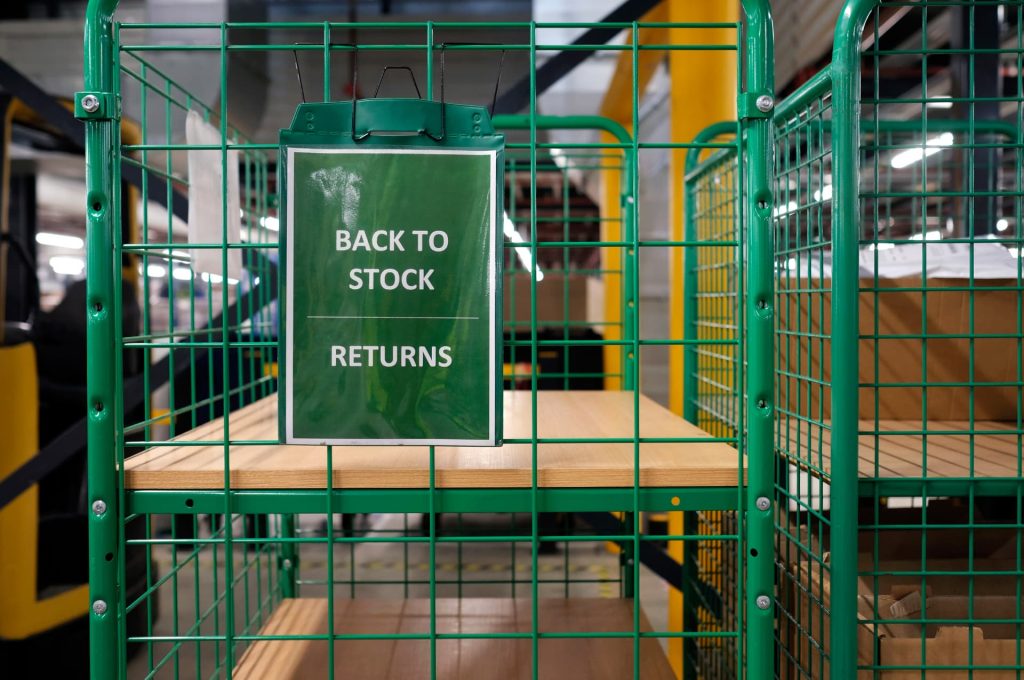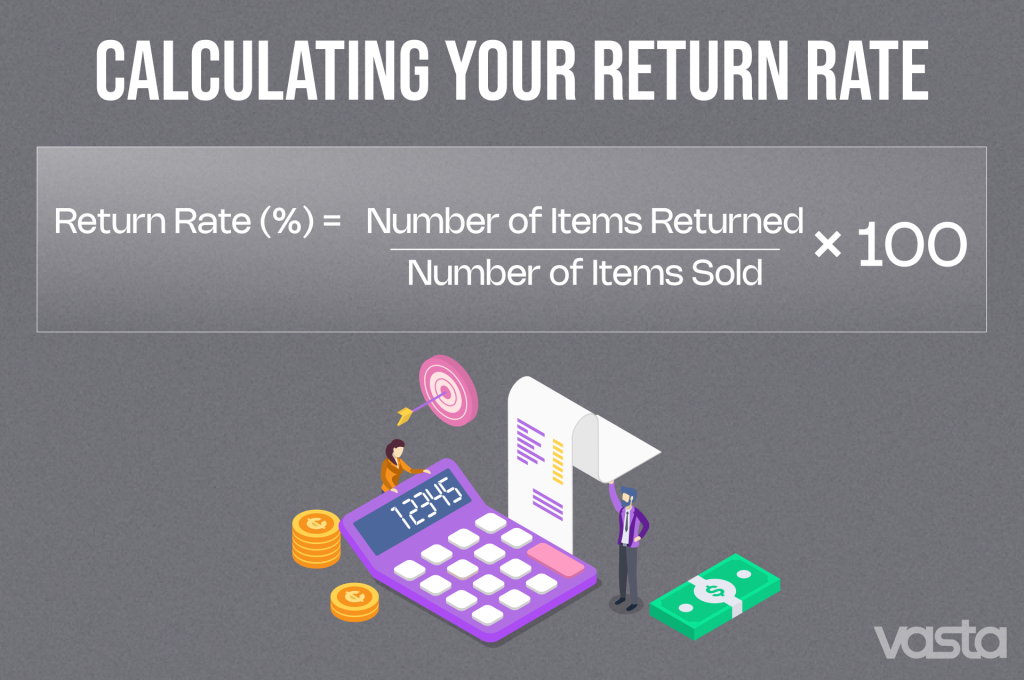Reducing the Impact: Effective Strategies to Minimize Returns and Refunds in Your eCommerce
Ever feel like handling returns and refunds is a bit like playing a never-ending game of whack-a-mole?
Just when you think you’ve got everything under control, up pops another return, ready to throw a wrench in your smooth-running operations.
It’s a reality many businesses face today, with a staggering 30% of all online purchases returning to the sender. Yes, you heard that right—nearly one-third of all that hard work is out for a return journey.
So, what’s a business to do? Understanding and addressing the reasons behind this trend will reduce these numbers, enhance customer trust, improve product satisfaction, and drive sustainable growth.
What Are Returns and Refunds in E-commerce?

As eCommerce business owners, you face the unique challenge of convincing customers to purchase items they can’t see or touch in person. It’s a hurdle that makes returns and refunds an integral part of your online stores’ customer service experience.
A return is when a customer sends back a product they purchased online. This could be due to various reasons—maybe the item didn’t match its description, came with the wrong item, arrived damaged, or simply didn’t meet the customer’s expectations.
E-commerce faces more challenges with return fraud than brick-and-mortar stores, where it’s easier to spot problems right away.
Following this, issuing a refund means reimbursing the customer for their purchase. While refunds are straightforward in principle, they encompass more than just the transactional aspect. They’re a statement of our commitment to customer satisfaction and trust.
For potential customers, swift and transparent service isn’t just a perk—it’s a fundamental right. The faster and clearer the process, the better the experience. On the flip side, for businesses, reducing exchanges and refunds is key to success and sustainable growth in retail sales.
How do e-commerce returns work?

Navigating the world of online shopping brings the convenience of comparing and purchasing products from the comfort of your home. However, what happens when an item doesn’t meet your expectations?
Understanding the returns process is crucial for any savvy online shopper and business.
1st Initiating a Return
Typically, this process begins when a customer decides that a product doesn’t meet their expectations. Whether it’s due to size, color, or simply buyer’s remorse, most e-commerce platforms have a standard procedure for initiating exchanges.
Customers usually fill out a return form online detailing their reason for the exchange.
- Pro Tip: Consider integrating your eCommerce platform with an exchanges management system to automate this process, providing a seamless experience for customers and reducing the workload on your customer service team.
2nd Returns Policy

E-commerce businesses have varying exchange policies, which outline the timeframe for exchanges, acceptable return conditions, and the refund method.
A standard window is 30 days from purchase, but this can vary significantly from one retailer to another.
- Pro Tip: Regularly review and adjust your policy based on customer feedback and returns rate. Consider whether product descriptions, images, or quality can be improved if certain products have higher rates.
- Pro Tip: Including FAQs on the exchange policy page can address common customer queries, reducing the need for direct customer service intervention.
3rd Logistics of Returns
Once this process is initiated, logistics come into play. For a customer-centric approach, providing a prepaid shipping label is common practice.
Retailers like Amazon have set a high standard by offering hassle-free return logistics, including drop-off points and home pickups. Small businesses can negotiate rates with shipping carriers or use third-party logistics services to manage exchange shipments effectively.
- Pro Tip: Use returns management software to track the status of returned items through the processing phase. This software can help you quickly restock items, issue refunds, and analyze essential data for insights.
4th Refunds and Exchanges

After inspection, businesses typically process a refund or exchange based on their policy and customer preference.
Refunds may be issued to the original payment method or as store credit. The refund timeline can also vary, with most aiming to process refunds within a few business days after receiving the returned item.
Offer flexible options for refunds and exchanges. Some customers may prefer a direct refund, while others might opt for store credit or an exchange for a different size or color.
- Pro Tip: If you decide to charge for returns, consider offering a discounted shipping rate or a flat fee to simplify the process for your customers. You might offer free exchanges for high-value items to build trust and encourage purchases.
- Pro Tip: Automate the refund process as much as possible to reduce customer wait times. Consider offering instant store credit as an incentive for customers to exchange rather than return items, which can help retain online sales.
5th Impact and Management
Returns can significantly impact ecommerce sales due to restocking expenses and potential loss of revenue. Effective exchange management, leveraging data analytics to understand and reduce return rates, is crucial for maintaining profitability.
Streamline the inspection and processing of returned items. This includes having a dedicated space for these items, training staff on inspection standards, and efficiently updating inventory.
Every exchange is an opportunity to learn about your customers’ preferences and pain points. Implementing a short survey in this process can provide valuable feedback to prevent future returns.
- Gather Feedback: Implement a system to gather feedback during the exchange process. Understanding why customers return items can provide valuable insights into product improvements, website enhancements, or customer service training needs.
Strategies to Reduce eCommerce Returns

With up to 30% of all online purchases ending up as returns, this way, business owners must develop strategies that minimize these occurrences without compromising on customer service.
1. Detailed Product Descriptions and Images

Imagine you’re buying a cake. You’d want to know if it’s chocolate or vanilla, right? The same goes for online shopping.
Just as diners prefer to know whether they’re ordering chocolate or vanilla cake, online shoppers and potential customers rely on product descriptions and visuals to guide their purchase decisions.
But how to do this correctly?
- Create content that brings your products to life. Use high-resolution images from multiple angles, videos showing the product in use, and detailed descriptions that cover every aspect a customer might be curious about.
This includes materials, dimensions, care instructions, and even the story behind the product.
- High-resolution images, 360-degree views, and detailed descriptions can help customers make informed decisions, reducing the likelihood of mismatches between customer expectations and reality.
Utility Tip: Utilize Adobe Lightroom to ensure your product images accurately represent product colors and details. Incorporate platforms like Curalate + Bazaarvoice to showcase user-generated content, offering prospective buyers a genuine glimpse of your products in action.
Example: IKEA’s Immersive Product Experience:
IKEA leverages AR technology through its IKEA Place app, allowing customers to see how furniture fits and looks in their actual space before purchasing. This has enhanced customer satisfaction and significantly reduced returns due to size and style mismatches.
2. Quality Control Checks

Nothing sends a product flying back faster than discovering it’s broken or not up to snuff.
Implementing rigorous quality control checks before shipping can significantly reduce returns due to damaged or defective items.
But how to do this correctly?
Data from the Quality Management Institute shows that implementing a comprehensive quality control system can reduce product returns by up to 23%. So, to do this well:
- Pre-Shipment Inspections: Develop a comprehensive quality control protocol with a checklist and photographic evidence of the product before shipping, similar to practices in high-value goods industries like luxury watches.
- Implementing regular audits of your inventory and a thorough inspection process can help catch issues before they reach the customer.
- Supplier Collaboration: Work closely with your suppliers to ensure they understand and meet your quality standards.
Utility Tip: Develop a quality control protocol that includes checklists for different product categories. Use mobile audit apps like SafetyCulture to perform regular quality checks.
Example: Samsung’s Commitment to Quality:
Samsung, a leader in electronics, attributes its low exchange rates to its commitment to quality at every stage of product development and testing. Their approach involves internal quality checks and extensive customer usage data to inform product improvements.
3. Size Guides and Virtual Fitting Tools

Did you know that one of the most common reasons for product returns, especially in the apparel and footwear industries, is getting the wrong size? Research indicates that size-related issues account for up to 40% of all online clothing exchanges.
Buying clothes online shouldn’t feel like a guessing game. With detailed size guides and virtual try-on apps, you’re giving your customers a virtual fitting room experience.
Ensuring your customers can find their perfect fit when shopping online is not just a courtesy; it’s a strategic move to reduce returns significantly.
But how to do this correctly?
According to a report by Body Labs, implementing virtual fit solutions can reduce return rates by as much as 50% for size-related issues. These technologies help customers feel more confident in their size selection and offer a fun, interactive way to shop online.
- Accuracy and Clarity: Ensure your size guides are accurate and easy to use, with clear instructions on measuring for the best fit.
- Technology Integration: Choose a virtual fitting solution that integrates seamlessly with your online platform, providing a smooth user experience.
- Customer Education: Use tutorials or videos to educate customers on using size guides and virtual fitting tools effectively.
- Feedback Loop: Encourage feedback on the accuracy of your size guides and fitting tools, using this input to make continuous improvements.
Utility Tip: Collaborate with companies like Metail or TryLive to provide customers with virtual fitting rooms.
Example: ASOS’s Approach to Sizing and Fit:
ASOS addresses online sizing challenges through its precise size guides and the ‘Fit Assistant’ feature, which gathers shoppers’ information on size, fit preferences, and body shape to suggest the most suitable size.
They showcase videos of models in varying sizes wearing the clothes, offering a genuine glimpse of how items fit diverse body types. This strategy reduces return rates and boosts customer satisfaction and trust by providing accurate sizing information and utilizing technology effectively.
4. Customer Reviews and Q&A Sections

Ever trust a friend’s recommendation more than an ad? That’s the power of customer reviews and Q&As. They’re like having your advisory council, guiding shoppers to make choices they won’t regret.
This peer feedback can address concerns and questions that might otherwise lead to exchange.
In the realm of online shopping, where customers can’t physically interact with products, the experiences of others can be incredibly influential.
But how do you implement this correctly?
According to a report by PowerReviews, products with reviews have a 12% lower return rate than those without. This highlights the power of peer insights in the purchasing process.
- Increase reviews: Encourage your customers to leave detailed reviews beyond star ratings. Ask them to comment on the fit, quality, and their overall satisfaction with the product.
- Answer them: Implement a system for potential buyers to ask questions and for past purchasers or your customer service team to answer them.
- Highlight Useful Reviews: Feature reviews that provide the most insight into the product’s use and quality.
- Respond to Questions Quickly: Ensure your team answers questions promptly, providing accurate and helpful information.
Utility Tip: Enhance your product pages with review widgets and Q&A features from Bazaarvoice or PowerReviews to build a community around your products. Platforms like Loox or VideoPeel offer services that make integrating video reviews straightforward.
Example: Zappos’ Approach to Customer Feedback:
Zappos excels in using customer reviews and Q&As to enhance buying decisions and reduce returns. They encourage detailed reviews and categorize them for easy navigation, such as reviews focusing on fit information. This strategy has enabled Zappos to cultivate a loyal customer base that feels confident in their purchases, reducing the likelihood of exchange.
5. Flexible and Clear Return Policies

It sounds like wizardry, but a clear and generous eCommerce return policy can spellbind your customers into keeping their purchases.
When customers feel confident they can exchange an item if necessary, they are more likely to be satisfied with their purchase and less likely to return it out of buyer’s remorse.
It’s the comfort of knowing there’s a safety net that encourages them to take the leap of faith with your products.
Craft your policy based on psychological principles, emphasizing the product’s value and the brand’s commitment to satisfaction. Highlight positive customer service experiences and easy resolution processes to build trust.
How To: Design a return policy that balances flexibility with fairness. Use platforms like Loop Returns to automate and personalize the exchange process.
6. Fine-Tuning Your Strategy with Data and Insights

Did you know that effectively analyzing exchange data can lead to groundbreaking insights that drastically reduce your ecommerce returns? It’s all about peering into the numbers and patterns to really understand what drives your customers to regret their purchases.
In today’s data-driven market, having a handle on the specifics of your returns can transform your approach and significantly impact your bottom line.
But how to do this correctly?
According to a study by the Harvard Business Review, companies that utilize analytics in their operations see a 5% to 6% increase in productivity and profitability compared to their peers.
- Start by integrating advanced analytics tools such as Google Analytics, Shopify Insights, or even specialized software like Looker, which can delve deeper into your merchant metrics.
- Segment your return data to identify specific patterns. Are certain products getting returned more than others? Are there recurring reasons for exchanges, such as size, color inaccuracies, or lack of product expectations?
- Implement A/B testing for changes you make based on analytics insights. If you adjust product descriptions or images based on exchange reasons, test these changes with control groups to measure their impact on return rates.
- Customer Feedback Integration: Combine quantitative data with qualitative feedback from returns to get a comprehensive view of the issues.
- To protect your business from serial returners, implement clear return policies, utilize data analytics to track return patterns, and consider restocking fees or rewards for low return rates.
Example: Best Buy’s data-driven approach to reducing exchanges:
Best Buy leverages detailed analytics to understand not just the “what” but the “why” behind product returns.
Analyzing data alongside customer feedback has identified and addressed common issues such as misleading product descriptions or inadequate customer education on tech products.
Adjustments based on these insights have led to a notable reduction in returns, showcasing the power of a well-informed strategy.
Minimizing Costs of Return To Your Ecommerce Store

Exchanges are inevitable in running an e-commerce business, but they don’t have to erode your profit margins. Online retailers can significantly reduce associated costs by optimizing customer return processes while maintaining customer satisfaction.
Streamlining the Process
- Automate the Process: Use platforms like Returnly or Shopify to automate exchange requests, approvals, and shipping label generation. Automation speeds up the process and reduces manual errors and administrative costs.
- Optimize Returns Policy: Clearly define what can be exchanged and under what conditions. A well-structured return policy can deter unnecessary exchanges by setting clear expectations.
- Leverage Local Return Centers: Partnering with local exchange centers or using services like Happy Returns can minimize shipping costs and expedite the exchange process.
- Educate Your Customers: Use your website and marketing communications to educate customers on making online return requests. This can include tutorial videos, FAQs, and step-by-step guides.
- Offer Alternative Solutions to Returns: Before processing an exchange, see if there’s an alternative solution that would satisfy the customer. This could be an instant store credit, repair service, or partial refund. Such alternatives can often be more cost-effective and maintain customer satisfaction.
Calculating Ecommerce Return Rate

The return rate is a critical metric for any e-commerce business, offering insights into customer satisfaction, product quality, and overall operational efficiency. Calculating this accurately can help you pinpoint areas for improvement and strategize more effectively to reduce exchanges.
Industry benchmarks vary, but a rate between 20% to 30% is common in e-commerce, particularly in apparel and fashion. Comparing your rate against industry standards can offer additional context for your performance.
Explaining the Formula:
- Gather Your Data: Start by collecting data on the total number of items sold and the number of items returned within a specific period, such as a month or quarter.
For example, if you sold 1,000 items last month and had 100 exchanges, your return rate would be (100/1,000) x 100 = 10%.
- Analyze the Results: A higher rate might indicate issues with product quality, inaccurate product descriptions, or customer service challenges. Conversely, a low return rate suggests high customer satisfaction and product reliability.
Calculating and understanding your e-commerce return rate is essential for identifying areas for improvement and making data-driven decisions to enhance customer satisfaction and operational efficiency.
Which is the best ecommerce returns software?

The right software can transform this challenge into an opportunity, enhancing customer satisfaction while minimizing costs.
Here’s your guide to the 4 top e-commerce reverse logistics software, ensuring your business stays ahead of the curve.
- Shopify Returns Manager: For Shopify store owners, this software integrates directly into the e-commerce platform, offering a straightforward solution for managing returns. It allows customers to submit exchanges through an automated system, simplifying the process for both parties.
- Returnly: It stands out for its customer-centric approach, allowing shoppers to get an instant credit refund for their next purchase before returning their original item. This unique feature can significantly boost customer loyalty and encourage repeat business.
- Happy Returns: It offers a comprehensive solution for online and in-store exchanges, facilitating seamless, box-free customer returns. Their extensive network of Return Bars allows customers to exchange items in person, simplifying logistics and reducing environmental impact.
- Narvar: It focuses on the post-purchase customer experience, offering a suite of tools that include returns management, tracking, and analytics. Their platform enhances customer communication throughout the exchange process, providing transparency and building trust.
Shop owners can easily connect the shipment software to their store, adjust shipping rules, and include return labels with every generated label.
Mastering E-commerce Returns for Business Success

A well-handled return process safeguards your bottom line and significantly enhances customer loyalty and trust. As we’ve explored, understanding return rates, leveraging the right software, and implementing strategies to minimize exchange costs are fundamental steps toward optimizing your e-commerce operations.
Key Takeaways:
- Data is King: Utilize analytics to understand your exchange patterns and make data-driven decisions to reduce return rates.
- Customer Experience is Paramount: A seamless, transparent return process can turn potentially negative experiences into positive customer touchpoints.
- Continuous Improvement is Essential: Use exchanges to gather feedback and improve your products and processes.
When managed effectively, eCommerce returns offer a unique opportunity to reinforce your brand’s commitment to customer satisfaction and the environment by reducing its carbon footprint. By embracing the challenges and insights exchanges provide, businesses can cultivate a loyal customer base and achieve sustainable growth.

